Biasing of Differential Amplifiers
Constant Current Bias:
In DC analysis of the differential amplifier, we have seen that emitter current IE depends upon value of the bdc. To make the operating point stable IE current should be constant irrespective of the value of bdc.
For constant IE, RE should be quite large. This increases the value of CMRR also but if RE value is increased to quite large value, IE (quiescent operating current) decreases. To maintain the same value of IE, emitter supply VEE should be increased. To obtain very high value of resistance RE and constant IE, current, current bias is used.
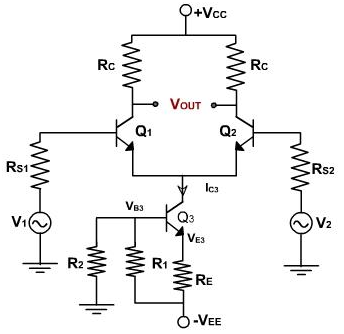
Figure 1
Figure 1, shows dual input balanced output differential amplifier by using a constant current bias. The resistance RE can be replace by the constant current transistor Q3. The DC collector current in Q3 can be established by R1, R2, & RE.
By applying the voltage divider rule, the voltage at base of Q3 is
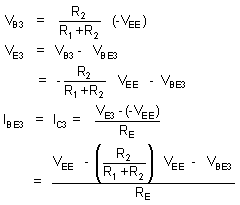
As the two halves of differential amplifiers are symmetrical, each has half of the current IC3.

The collector current, IC3 in transistor Q3 is fixed as no signal is injected into either the emitter or base of Q3.
Besides supplying the constant emitter current, constant current bias provides a very high source resistance also since the AC equivalent or DC source is ideally an open circuit. Thus, all the performance equations obtained for the differential amplifier by using the emitter bias are also valid.
As seen in the IE expressions, current depends upon the VBE3. If the temperature changes, VBE changes and current IE also changes. To improve the thermal stability, a diode is placed in series with the resistance R1as shown in the figure 2.
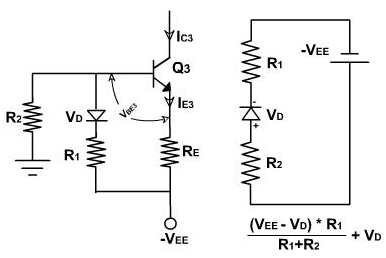
Figure 2
It helps to hold the current IE3 constant even if the temperature changes. By applying KVL to the base circuit of Q3.
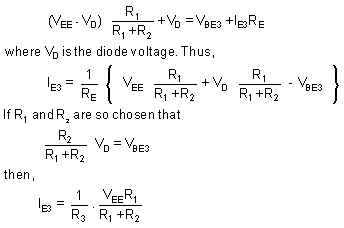
Thus, the current IE3 is constant and independent of the temperature due to the added diode D. In the absence of D the current would vary with temperature because VBE3 decreases approximately by 2mV/° C. The diode has same temperature dependence and hence the two variations cancel each other and IE3 doesn't vary appreciably with the temperature. Since the cut - in voltage VD of diode is approximately same value as the base to emitter voltage VBE3 of a transistor the above condition cannot be satisfied with one diode. Therefore 2 diodes are used in the series for VD. In this case common mode gain reduces to zero.
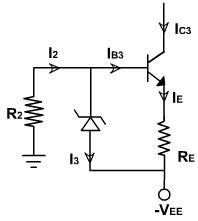
At times zener diode can be used in place of the diodes and resistance as shown in the figure 3. Zeners are available over the wide range of voltages and can have the matching temperature coefficient
The voltage at base of transistor QB is
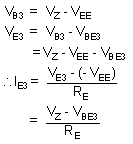
Value of R2 is selected so that I2 » 1.2 IZ(min) here IZ is minimum current needed to cause the zener diode to conduct in reverse region, which is to block the rated voltage VZ.

Current Mirror:
The circuit in which output current is forced to equal the input current is said to be a current mirror circuit. Therefore in a current mirror circuit, the output current is a mirror image of input current. The current mirror circuit is shown in the figure 4.
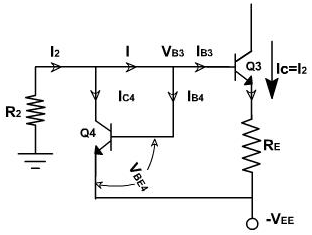
Figure 4
Once the current I2 is set up, the current IC3 is established automatically to be approximately equal to I2. The current mirror is the special case of constant current bias and current mirror bias requires of constant current bias and thus can be used to set up the currents in differential amplifier stages. The current mirror bias requires few components than the constant current bias circuits.
As Q3 and Q4 are identical transistors current and voltage are nearly same
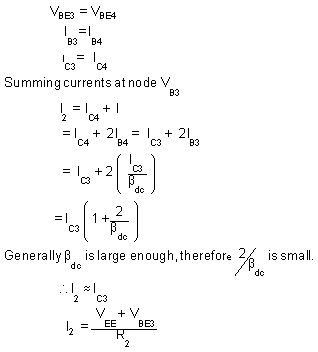
For the satisfactory operation the two identical transistors are essential.
Email based Electronics Devices and circuits assignment help - homework help at Expertsmind
Are you searching Electronics Engineering assignment help expert for help with Biasing of Differential Amplifiers- Constant Current Bias questions? Biasing of Differential Amplifiers- Constant Current Bias topic is not easier to learn without any external help? We at www.expertsmind.com offers free lecture notes for Electronics Devices and circuits assignment help and Electronics Devices and circuits homework help. Live tutors are available 24x7 hours for helping students in their Biasing of Differential Amplifiers- Constant Current Bias related problems. We provide step by step Biasing of Differential Amplifiers- Constant Current Bias question's answers with 100% plagiarism free content. We prepare quality content and notes for Biasing of Differential Amplifiers- Constant Current Bias topic under Electronics Devices and circuits theory and study material. These are avail for subscribed users and they can get advantages anytime.
Why Expertsmind for assignment help
- Higher degree holder and experienced experts network
- Punctuality and responsibility of work
- Quality solution with 100% plagiarism free answers
- Time on Delivery
- Privacy of information and details
- Excellence in solving electronics engineering questions in excels and word format.
- Best tutoring assistance 24x7 hours